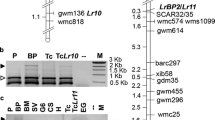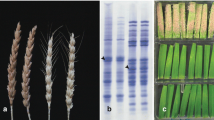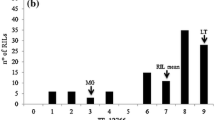Abstract
In order to map genes determining resistance to bacterial canker in tomato, backcrosses were made between a resistant and a susceptible Lycopersicon peruvianum accession. The linkage study with RFLP markers yielded a genetic map of L. Peruvianum. This map was compared to that derived from a L. esculentum x L. pennellii F2 population, based on 70 shared RFLP markers. The maps showed a good resemblance in both the order of markers and the length of the chromosomes, with the exception of just one relocated marker on chromosome 9. Because backcrosses were made with the F1, either as the pollen parent or as the pistil parent, linkage maps from male and female meioses could be estimated. It was concluded that recombination at male meiosis was reduced, and that gametophytic selection for parental genotypes at more than one locus per chromosome might be partly responsible for the reduction of the estimated male map length.
Similar content being viewed by others
References
Bonierbale MW, Plaisted RL, Tanksley SD (1988) RFLP maps based on a common set of clones reveal modes of chromosomal evolution in potato and tomato. Genetics 120:1095–1103
Burt A, Bell G, Harvey PH (1991) Sex differences in recombination. J Evol Biol 4:259–277
De Vicente MC, Tanksley SD (1991) Genome-wide reduction in recombination of backcross progeny derived from male versus female gametes in an interspecific cross of tomato. Theor Appl Genet 83:173–178
Feinberg AP, Vogelstein B (1983) A technique for radiolabelling DNA restriction endonuclease fragments to high specific activity. Anal Biochem 132:6–13
Hogenboom NG (1973) A model for incongruity in intimate partner relationships. Euphytica 22:219–233
Klein-Lankhorst RM, Rietveld P, Machiels B, Verkerk R, Weide R, Gebhardt C, Koornneef M, Zabel P (1991) RFLP markers linked to the root knot nematode resistance gene Mi in tomato. Theor Appl Genet 81:661–667
Lander ES, Green P, Abrahamson J, Barlow A, Daly MJ, Lincoln S, Newburg L (1987) MAPMAKER: an interactive computer package for constructing primary genetic linkage maps of experimental and natural populations. Genomics 1:174–181
Lindhout P, Purimahua C (1987) Resistance against Corynebacterium michiganense found in Lycopersicon peruvianum. In: Cuartero J (ed) Synopsis of the 10th EUCARPIA meeting of the Tomato Working Group, Pontecagnano, Italy, pp 162–165
Lindhout P, Purimahua C (1989) Investigations on tomato breeding for resistance to Corynebacterium michiganense. In: Book of poster abstracts, Part II. XIIth EUCARPIA Congress, Science for Plant Breeding, Göttingen, Germany, pp 16–8
Miller JC, Tanksley SD (1990) RFLP analysis of phylogenetic relationships and genetic variation in the genus Lycopersicon. Theor Appl Genet 80:437–448
Paterson AH, Damon S, Hewitt JD, Zamir D, Rabinowitch HD, Lincoln SE, Lander ES, Tanksley SD (1991) Mendelian factors underlying quantitative traits in tomato: comparison across species, generations, and environments. Genetics 127:181–197
Rick CM (1969) Controlled introgression of chromosomes of Solanum pennellii into Lycopersicon esculentum: segregation and recombination. Genetics 62:753–768
Rick CM (1986) Reproductive isolation in the Lycopersicon peruvianum complex. In: D'Arcy WG (ed) Solanaceae, biology and systematics. Columbia University Press, New York, pp 477–495
Sambrook J, Fritsch EF, Maniatis T (1989) Molecular cloning: A laboratory manual, 2nd edn., 3 vol. Cold Spring Harbor Laboratory, Cold Spring Harbor, New York
Stam P (1993) Construction of integrated genetic linkage maps by means of a new computer package: JoinMap. Plant Jour 3:739–744
Tanksley SD, Mutschler MA (1990) Linkage map of the tomato (Lycopersicon esculentum)(2n=24). In: O'Brien SJ (ed) (1990) Genetic maps, 5th edn. Cold Spring Harbor Laboratory Press, New York, pp 6.3–6.15
Tanksley SD, Ganal MW, Prince JP, De Vicente MC, Bonierbale MW, Broun P, Fulton TM, Giovannoni JJ, Grandillo S, Martin GB, Messeguer R, Miller JC, Miller L, Paterson AH, Pineda O, Röder MS, Wing RA, Wu W, Young ND (1992) High-density molecular linkage maps of the tomato and potato genomes. Genetics 132:1141–1160
Upholt WB (1977) Estimation of DNA sequence divergence from comparison of restriction endonuclease digests. Nucleic Acids Res 4:1257–1265
Van der Beek JG, Verkerk R, Zabel P, Lindhout P (1992) Mapping strategy for resistance genes in tomato based on RFLPs between cultivars: Cf9 (resistance to Cladosporium fulvum) on chromosome 1. Theor Appl Genet 84:106–112
Van Ooijen JW (1994) DrawMap: A computer program for drawing genetic linkage maps. J Hered 85:66
Author information
Authors and Affiliations
Additional information
Communicated by J. W. Snape
Rights and permissions
About this article
Cite this article
van Ooijen, J.W., Sandbrink, J.M., Vrielink, M. et al. An RFLP linkage map of Lycopersicon peruvianum . Theoret. Appl. Genetics 89, 1007–1013 (1994). https://doi.org/10.1007/BF00224531
Received:
Accepted:
Issue Date:
DOI: https://doi.org/10.1007/BF00224531




